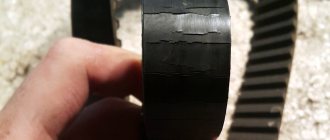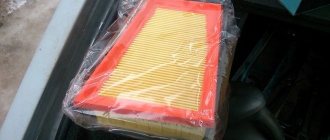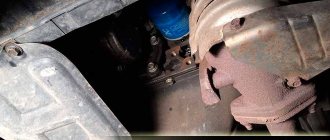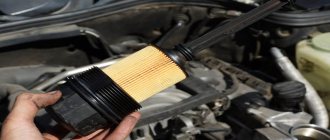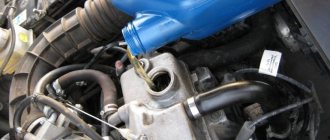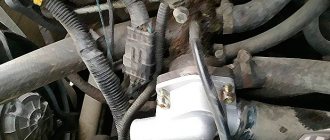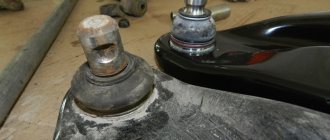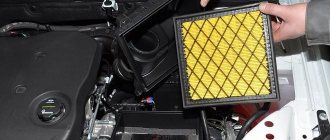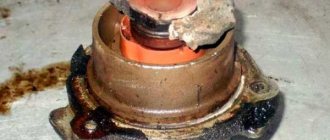1200 rub. for the photo report
We pay for photo reports on car repairs. Earnings from 10,000 rubles/month.
Write:
Changing the oil in the Lada Largus engine is a common procedure for periodic vehicle maintenance, which is performed approximately every 15 thousand km. mileage (some drivers change it to 10). Any man can change the engine oil with his own hands—there’s nothing complicated about it.
Changing the oil in a Lada Largus (16 valves) involves removing the crankcase protection. Otherwise, you won’t be able to get to the oil filter, which also needs to be replaced. After removing the protection, you need to place a container for used oil, unscrew the drain plug, and drain the oil.
While he's running away, you can work on the oil filter. To remove it, you will need a puller . There are several types of oil filter pullers, but in this case the so-called “crab” is most suitable.
This video with instructions will allow you to see how to change the oil and oil filter on a Lada Largus.
The choice of oil for internal combustion engines should be given special attention, since the operation of your vehicle depends on its quality. Therefore, you need not only to replace it on time, but also to know what consumables to fill. Now you can find out which engine oil is suitable for Lada Largus and how to change it.
Operating principle of the oil filter
The cleaning component of Lada Largus consists of dense fabric (paper), the structure of which includes synthetic, cellulose and glass fibers.
By passing the flow of engine oil through itself, the fabric traps dirt and wear products from the metal parts of the engine. To give the filtration element additional rigidity, it is treated (impregnated) with a special resinous agent. The paper is folded like an accordion and rolled into a cylinder, onto which metal rings are glued.
A feature of the filter is that after turning off the ignition and completely stopping the car engine, a small amount of oil fluid should remain in the system. For this purpose, the oil purifier is designed with an anti-drainage rubber valve. Often, it is the violation of its integrity that many non-original spare parts and counterfeits suffer from.
Every part of a car has its pros and cons. Here are a few disturbances that may occur during the operation of the filter device:
if the filter is very dirty, the bypass valve opens and circulation of uncleaned engine oil begins, which leads to rapid wear of engine parts
If you do not pay attention to this in time, you can get more serious problems in the operation of the engine; installation of a new device should only occur simultaneously with changing the lubricant, otherwise the old uncleaned oil will continue to clog the filter; A rare problem, but it exists when coolant enters the system due to a leak.
Typical signs of stabilizer link malfunctions
Despite the omnivorous nature of the Lada Largus suspension, it can also quickly fail. The main reasons for this are driving on broken roads, active driving and sudden maneuvers, and overload. The malfunction can be easily diagnosed visually by examining the unit, or by indirect signs:
- increased roll and the appearance of diagonal rocking;
- demolition of the car axle during rearrangement;
- metallic knock in the front;
- longitudinal swing during braking;
- inadequate operation of the braking system with abs;
- deterioration in controllability, acute reaction to asphalt rutting.
This is the most accurate way to diagnose the problem. Turn the wheel all the way and rock it back and forth. Excessive play indicates that the rack has exhausted its service life. Also, on the inspection hole, use a pry bar or hand to press the lever at the place of its attachment. Squeaks and rattles, as well as free movement, are all signs of a faulty part. An indicator for replacement is cracking of the rubber or uneven wear, even if there is no play.
Where is the oil filter located?
The oil filter in the Lada Largus is located next to the crankcase and the drain plug. It is easy to recognize by its cylindrical case, which is predominantly blue. It can be unscrewed by hand, but if it is tightened too tightly, additional tools may be required.
In some assemblies, the location of the filter element may vary. To obtain the necessary information, refer to the technical documentation or find the oil filter yourself. Also, for easy access to it, additional steps may be required to dismantle the pipes and units.
Preparation for replacement and necessary tools
The process of preparing to replace the Largus oil filter includes three main points:
- purchase of new parts and consumables;
- parking the car on level ground;
- warming up the engine to operating temperature if it has not been running for a long time.
For convenience, it is recommended to use an overpass, inspection hole or lift. In the absence of the appropriate opportunity, the car is raised using a jack and supports.
When working with oil, pay attention to safety precautions. The main emphasis is on its high temperature and toxicity
To avoid thermal and chemical burns, the entire procedure should be performed with rubber gloves and overalls.
The list of tools for replacing the oil filter in Lada Largus consists of the following equipment:
- a set of keys and screwdrivers, a collar with attachments, a probe, pliers;
- clean, lint-free rags or rags, rubber gloves;
- container for draining used lubricant;
- new oil, funnel for filling;
- new oil filter, seals and gaskets, and other components to replace worn parts.
During the preparation process, it is also recommended to check the system for worn connections, which can soon lead to breakdowns and leaks. Preventative replacement of parts allows you to avoid costly repairs and unforeseen complications.
Step-by-step replacement instructions
The sequence of replacing the oil filter for Lada Largus implies the following procedure:
- in the engine compartment, uncork the filler neck;
- dismantle the lower engine protection;
- Place a container under the drain in the lower part of the crankcase and unscrew the plug;
- the heated lubricating fluid usually drains within 10-15 minutes;
- during this time, clean the plug, change the washer if necessary;
- They also place a container for used lubricant under the oil filter and unscrew it;
- remove the cartridge, make sure that the perforated tube remains in place, clean the internal cavity of the casing dry;
- the rubber seals of the new filter element are lubricated with oil, some also wash the filter itself;
- Next, the filter element is mounted in place, while tightening, monitor the position of the sealing rubber bands - if they come out of the grooves, a leak will soon appear;
- tighten the drain plug, return the system to its original form;
- New lubricant is poured into the filler neck.
Read more: Changing the oil in the Niva gearbox
Based on the volume of oil poured, they are guided by the amount that was drained. Some experts recommend immediately filling it to the maximum, arguing that as the engine warms up, the oil will disperse throughout the system.
After filling, start the engine and let it run for 10-15 minutes. At first, the emergency light may come on, indicating a lack of oil in the system.
After warming up, measure the lubricant level - in the heated state, its amount should not exceed the upper permissible limit on the dipstick. If necessary, the excess is pumped out with a syringe or bulb.
It is also recommended to measure the oil level when the engine has cooled down - the volume should not be below the permissible minimum. After the first trips, it is recommended to check the system and oil filter for leaks.
LADA > Largus
We carry out the work of changing the oil and oil filter in the 16-valve Lada Largus engine on an inspection ditch or overpass.
We carry out the replacement with the warm engine not running, preferably immediately after the trip, before the oil has cooled down.
Remove the oil filler cap.
All actions “step by step”
Before changing the oil, warm up the engine. For convenience, you can place the car on the overpass. It would be advisable to open the filler plug. Then, taking a 12mm hex key or a 17mm round key, unscrew the drain plug.
The main thing is to completely drain the “working off”
After making two turns with the key, replace the empty container. Then the plug is unscrewed by hand.
The oil draining process will take 6-8 minutes. The crankcase contains 3.5 liters of fluid, but not everything will drain. At the last stage, the plug is returned to its place. The tightening torque for the drain plug for VAZ engines is not standardized. But it is indicated for the manual transmission unit - the force should be 30-46 N*m.
How to change the oil filter
To replace the filter, you first need to open the hood. Then, taking a puller, unscrew the filter housing. Direction: counterclockwise.
Oil filter removed
Instead of a puller, you can use a screwdriver. The filter housing is pierced closer to the bottom, and a screwdriver is used as a lever.
There is one connector on the engine near the filter. It would be better to turn it off.
DPKV sensor socket
We do the shutdown like this:
- Disconnect the negative terminal from the battery (open-end wrench “10”);
- Temporarily disconnect the connector.
The connection can be completed before installing the new filter.
The filter housing that will be installed is first filled with oil. You need to fill in 70-100 ml (a third of the volume).
Here we went a little overboard with the volume.
The rubber ring is also treated with new oil. Then installation is carried out, being careful not to touch important components.
Filling the engine with oil
You need to make sure once again that the “bottom plug” is tightened and the filter is screwed in all the way. The crankcase is filled with oil through the upper neck.
The refueling process is the simplest step
You will need to pour in exactly 3.3 liters. Then close the neck and start the engine. You need to wait exactly one minute: if the lamp on the device goes out, it means the volume was selected correctly.
When the engine is stopped, you need to wait 2-3 minutes. Then the oil level is checked using the dipstick. And then, having returned the dipstick to its place, they top up or pull out excess material from the neck. In the latter case, use a thin tube.
The dipstick on the VAZ-11189 engine really exists!
Articles (must read!)
The plug is unscrewed from the bottom of the crankcase. It is supplied with a washer. These parts are not sold as a set, only individually.
Drain plug and washer
The article number of the plug is 7703075348. We were able to find three articles for the washer: 110265505R, 8200641648, 7703062062. In the latter case, it will just be a copper ring.
Those who screw in the plug without the washer have themselves to blame. The oil will flow out of the pan, but not immediately.
The washer can be made from a sheet of copper. The internal diameter should be 16.7 mm. If the dipstick is lost, it’s not a problem. Use article number 8200666287.
Selection of analogues
Firstly, the drain plug has alternative part numbers - 7703075210, 7703075347, 7903075033. Analogs for it:
Show hidden content
The washer with a rubber band also has analogues:
Show hidden content
Filter part numbers can be found in other text.
Source
Instructions for changing engine oil Lada Largus (K7M and K4M)
20 August 2015 LadaOnline 70 425
For Lada Largus, it is recommended to change the engine oil every 15,000 km. or after 1 year (whichever comes first). Under severe operating conditions (large city, very dusty area), replace the oil and filter every 7-8 thousand km.
| K7M (8 valve) | 3.3 liters | ELF SOLARIS RNX 5W-30 | Motor oils with quality class API SL / API SM / API SN / ACEA A1/ ACEA A2/ ACEA A3/ ACEA A5 and SAE viscosity level: 15W40; 15W50 10W40; 5W30; 5W40; 5W50; 0W30; 0W40 (depending on climatic conditions). |
| K4M (16 valve) | 4.8 liters |
How to drain engine oil
You will need: buy engine oil and an oil filter, prepare a “10” wrench, an “8” square wrench, a clean cloth, an empty 5 liter container. and a wire brush.
The engine oil should be drained after a trip while the engine is still warm (if necessary, warm it up to operating temperature). It is recommended to drive the car onto an overpass.
Procedure:
- Unscrew the oil filler plug.
- (At the bottom of the car on the engine crankcase), clean the drain plug with a wire brush, then unscrew it. Be careful not to burn yourself!
- After all the oil has run out (about 10 minutes) into a previously placed container, clean the plug from dirt and screw it back.
Under the plug there is a steel washer on the surface of which a thin layer of rubber is vulcanized. If it is damaged, replace the washer with a new one. If you do not have a new washer, you can install a copper washer with a hole diameter of 18 mm under the plug.
How to replace the oil filter
You will need: a 10" or 13" wrench, a puller or a screwdriver.
On the K4M engine, access to the oil filter is blocked by the engine protection, which will have to be removed (6 x 10 screws). Or remove the fuel frame protection from above by unscrewing the 2 “13” screws. Place an empty container under the filter and turn it counterclockwise using a puller.
If you don’t have a special tool, you can use a screwdriver. For easier access to the filter on the K7M engine, you can remove the exhaust manifold thermal shield by unscrewing the three mounting screws. Then pierce the filter housing with a screwdriver (closer to the bottom of the filter, so as not to damage the motor fitting), unscrew the filter, using the screwdriver as a lever.
Fill the new filter 1/3 full with new engine oil and lubricate the sealing ring with it. Then install the oil filter, tightening it by hand until the O-ring comes into contact with the cylinder block. After this, tighten the oil filter another 3/4 turn.
How to fill engine oil
We pour new oil into the engine through the oil filler neck, the amount of oil in the engine is indicated in the table above. (about 0.3 liters of oil will still remain in the engine). We control the level using the oil dipstick (the oil level should be between the MIN and MAX marks).
Start the engine and let it idle for a few minutes. The emergency oil pressure indicator should go out 2-3 seconds after starting the engine. While the engine is running, check for oil leaks from under the drain plug and oil filter. Stop the engine and check the oil level; if necessary, add oil to the specified level.
The entire process of changing the Lada Largus oil is also shown in the video:
Changing engine oil of a different brand
If you decide to change the brand of oil, flush the lubrication system with flushing oil or oil of the brand that will be used.
To do this, after draining the old oil, fill in new oil up to the bottom mark of the oil dipstick. Start the engine and let it idle for 10 minutes.
Drain the oil and only then replace the oil filter. Now you can fill in new oil up to the top mark on the dipstick.
Let us remind you that pay special attention to choosing high-quality motor oil. Keywords: lubrication system Lada Largus | Lada Largus engine | Lada Largus filters. Keywords: lubrication system Lada Largus | Lada Largus engine | Lada Largus filters
Keywords: lubrication system Lada Largus | Lada Largus engine | Lada Largus filters
3 3
Found an error? Select it and press Ctrl+Enter..
What kind of oil to fill in the engine of VAZ LADA cars Changing the oil in the engine of a Lada car About oil consumption in Lada Priora, Kalina and Granta engines
Oil filter selection
The purpose of the oil filter is to clean the engine lubricant from foreign impurities in the form of wear residues formed during engine operation and carbon deposits from burned fuel. Once in the engine, they negatively affect its operation, increasing wear and reducing the service life of the unit, and can also lead to its breakdown and costly repairs.
Most oil filters consist of a non-separable metal cup, inside of which there is a filter element and two valves: anti-drainage and bypass.
The first is designed to prevent oil from flowing into the crankcase; it is installed at the inlet and closes as soon as the engine stalls. The bypass valve begins to operate in the event of a filter failure or increased viscosity of the oil substance. You should choose a filter recommended by the manufacturer.
Signs of sensor malfunction
Since fuel dosing and the ignition system are adjusted based on the signals of this sensor, its malfunction leads to signal distortion and, as a result, interruptions in the functioning of the power plant or the inability to start.
Signs of a broken crankshaft sensor are:
- the engine does not start and the “Check engine” signal;
- difficulty starting the engine;
- instability of engine operation under different modes;
- a noticeable drop in engine power for no apparent reason;
- When the load increases, engine detonation appears.
If at least one of these malfunction indicators appears, you should find out whether the sensor is the cause of the engine malfunction. But to do this you need to know how to check the crankshaft sensor.
This is interesting: Repair of Lada Largus roof rails
Replacement frequency, what oil to fill
According to the manufacturer's regulations, engine oil service changes are carried out after 15,000 kilometers or at intervals of 1 year. But many motorists consider this interval to be very high, recommending that it be reduced taking into account operating conditions.
At the factory, the Lada Largus model is filled with oil from different suppliers. But most often it is Lukoil Genesis Armortech 5W40 or Rosneft Maximum Service 5W-30. For more accurate information about what is poured into your car from the factory, you should contact the feedback system of PJSC AVTOVAZ. When applying, you must indicate the year and month of manufacture of the car.
If you follow the manufacturer's recommendations, then on new cars you must use Rosneft Premium 5W-40 synthetic oil. And for cars with high mileage, switch to semi-synthetic Rosneft Maximum 5W-40. By the way, about the recommendation for filling Rosneft, there is an inscription on the filler neck located on the engine.
Another option that the manufacturer supports is the official Lada Ultra 5W-40 product. It is bottled by Lukoil, and it is positioned as synthetic, although the label says “Synthetic technologies”. Because of this inconspicuous slogan, one has to wonder if it is actually synthetic?
There is a category of people who will never fill up with oil from a domestic manufacturer. Everyone has their own reasons and arguments for this. Having conducted tests among Western manufacturers, fans of this model speak very highly of Elf Evolution 900 NF 5W-40. And on cars with high mileage, Shell semi-synthetics perform well.
Replacement frequency
The incredible beauty “Lada Largus” is a joint “product” of AvtoVAZ and the Renault-Nissan concern. If you want your car to fly smoothly and beautifully along the highways, then we recommend listening to the manufacturers' recommendations. Who better to know the needs of their “child” than the parent-producer.
The oil change in Largus is carried out after the car has covered fifteen thousand kilometers. We recommend not to postpone the deadline for technical manipulation. In addition, let us reveal the secret that many car owners prefer to replace the motor fluid after a mileage of 10 thousand kilometers. This is no coincidence, since the parameters specified by the manufacturer are designed for ideal operating conditions
They do not take into account the terrible quality of the road surface, bumpy trips, or the use of cheap fuel.
Please also note that you will have to change the engine fluid even if your car only covers a few tens or hundreds of kilometers, if at least one year has passed since the last change. Oil loses its quality characteristics not only during constant operation of the vehicle, but also as a result of prolonged downtime.
Payment via Yandex Cashier
After selecting payment via Yandex, the Yandex Cashier payment system will launch, where you need to select a convenient payment method (bank card, QIWI, Yandex Money account, etc.)
After specifying payment details and confirming payment, payment for the goods will occur.
If you have a bank card in a currency other than the ruble, then the money will be debited from the card at the rate of the Central Bank of Russia at the time of the purchase.
This payment method is optimal for residents of Russia, Kazakhstan and Belarus.
Removal and replacement instructions
Replacing a consumable component such as an oil filtration element is integral to the process of updating the lubricant in the system. However, before starting work, some preparation is required. As tools, materials and components we will need:
- ratchet type wrench;
- extension for key;
- heads 8-17 mm. (depending on the engine model);
- oil filter puller (or large flat screwdriver);
- empty container for draining old lubricant (any plastic canister from non-food products will do);
- a pair of clean and dry rags;
- container with new oil;
- new filter element.
To carry out the work, you need to find where the filter element of the Lada Granta lubrication system is located. The replacement procedure is carried out with the motor not running. However, before this it must be warmed up. This is done in order to dilute the old lubricant. Then it will better flow out of all channels and there will be as little of it left in the system as possible. Otherwise, this will lead to a decrease in the performance of the new lubricant.
Now let’s look directly at what stages include replacing the filter element and lubricant in the Lada Granta internal combustion engine:
- After the machine is installed above the inspection hole or overpass, and the engine is still hot, you can remove the engine oil filler cap.
- The 16-valve engines of this car model are equipped with a shield to protect the engine compartment from dirt. It needs to be removed.
- Next, the driver inspects the engine oil pan and cleans the area near the drain hole from dirt and soot. You can loosen the drain plug using a wrench with a corresponding head (they are different for 16 and 8 valves).
- An empty container is placed under the hole and the plug is completely unscrewed. All you have to do is wait until all the old grease drains out. This may take up to 20 minutes.
- The used oil is drained until individual drops begin to drip from the hole. The area around it is wiped with a clean and dry cloth. The plug is screwed back into place.
- You need to disconnect the block with the wires that lead to the crankshaft sensor. This is done in order not to damage them when the filter element is unscrewed.
- Now you should disconnect the tip of the wires leading to the lubricant pressure sensor. Its residues are removed from the oil filter into a container for draining the “working off”.
- To change the oil filter, it must be unscrewed counterclockwise. This rule applies not only to the Lada, but also to other cars. If this cannot be done by hand, you will have to use a removable key or break the case with a screwdriver, and then use it as a lever.
- After the filter is dismantled, its seat is thoroughly wiped from any remaining dirt.
- Approximately half of its body is filled with a new filtration element with clean oil, and the seat ring is also lubricated. It is twisted by hand until it stops, and then another ¾ turn.
- You can fill the engine with new engine oil. During the filling process, the volume and level are regulated by a measuring probe. The lid is screwed on after topping up.
- The engine is started and allowed to run for 1-2 minutes. As soon as the low pressure warning light in the system goes off, it can be turned off. You should also make sure that there are no leaks at the mounting location.
- A few minutes after the motor has cooled, you can measure the level again with a dipstick. If necessary, add oil according to the required volume.
Work on replacing the oil filter and fresh lubricant can be done in a garage and without paying for the expensive services of technicians from a service station. Throughout the entire period of operation, the volume and quality of the lubricant should be monitored. Replacements of these consumables must be made in a timely manner.
Signs of a malfunction of the oil pressure sensor on a Priora and methods for checking for serviceability
A characteristic sign of a malfunction of the device is the glow of an indication in the form of an oil can on the instrument panel when the engine is running. The indicator may also glow intermittently at high crankshaft speeds (over 2000 rpm), which also indicates a breakdown of the product. If you use a dipstick to check that the oil level is normal, then most likely the oil pressure sensor (oil pressure sensor) has failed. However, this can only be confirmed after checking it.
You can check and make sure that the cause of the glow of the oil can on the instrument panel is DDM by performing its test manipulations. The easiest way to check is to install a known-good sensor together with the standard product. And although it is inexpensive, few people are in a hurry to buy it, and in vain, because DDM on the Priora is one of the many diseases of the car.
To check the oil sensor on a Priora for serviceability, you need to remove it from the car. How to do this and where it is located is described in detail below. After removing the product, you need to assemble the circuit, as shown in the photo below.
From the thread side, compressed air from the compressor must be supplied into the hole. In this case, the lamp should go out, which indicates that the membrane is working properly. If the lamp does not light up when assembling the circuit, this may indicate that the membrane is jammed in the position with open contacts. You can verify this by testing the product with a multimeter.
REPLACEMENT
AvtoVAZ engineers recommend replacing the oil and oil filter in a Lada Largus with 16 valves every 15 thousand km. If the replacement is not carried out on time, this may affect the operation of the motor. Replacement can be carried out earlier if operating conditions were difficult.
To carry out the work you will need the following tools:
- engine oil;
- waste oil canister;
- keys;
- puller for removing the filter;
- funnel;
- rags or rags.
Attention! In the absence of a special puller, you can use a belt or a screwdriver. To drain used oil, you can use any old container, even an ordinary bottle. To complete all the procedures you will need to lift the car on an overpass or drive the Largus into a pit
The replacement procedure is carried out with the engine warm. If the Largus has not been used, then it needs to be allowed to idle for several minutes. On an 8-valve Largus engine, it is easier to replace the lubricant - the drain plug is unscrewed through the slots in the crankcase protection. In the 16-valve Lada Larus engine, to replace the oil filter, you need to remove the protection
To complete all the procedures, you will need to lift the car on an overpass or drive the Largus into a pit. The replacement procedure is carried out with the engine warm. If the Largus has not been used, then it needs to be allowed to idle for several minutes. On an 8-valve Largus engine, it is easier to replace the lubricant - the drain plug is unscrewed through the slots in the crankcase protection. In the 16-valve Lada Larus engine, to replace the oil filter, you need to remove the protection.
Please note! In the absence of the ability to lift the car, the drain neck can be opened through the hood. But you will have to remove the fuel rail protection.
Causes of malfunction
The front wheel bearing is a fairly strong part in its structure, and in order to prematurely fail it requires the application of truly significant efforts. With adequate operation, this suspension component exhibits enviable survivability, without annoying the owner with hints of its malfunction. Only natural wear and tear over a long run can affect the condition of this component.
If we touch on the reasons for the failure of the bearing we are considering, we can highlight several aspects:
- Increased mileage. Bearing failure in a Lada Largus can make itself felt after a mileage of 60 to 110 thousand km. This parameter is individual for each model. It is also directly influenced by operating conditions. The occurrence of a breakdown will be indicated by a specific crunching sound coming from the front wheel area. Almost every driver knows about this sound accompaniment of a malfunction.
- Loss of tightness. The separator part of the bearing is covered with plastic casings. They allow the lubricant to be retained and reduce the amount of friction that occurs when the internal race of the product rotates together with the hub. Over time, these protective elements become unusable, after which dirt penetrates into the working area, washing away the lubricant. Soon a hum appears, which hints to the owner that the node needs to be diagnosed.
- Extreme riding. Broken roads are not the ally of wheel bearings. Regular driving of the Lada Largus over potholes mercilessly damages these seemingly reliable suspension elements.
- Incorrect installation. An incorrectly replaced bearing will not perform its functions and will soon require another replacement.

